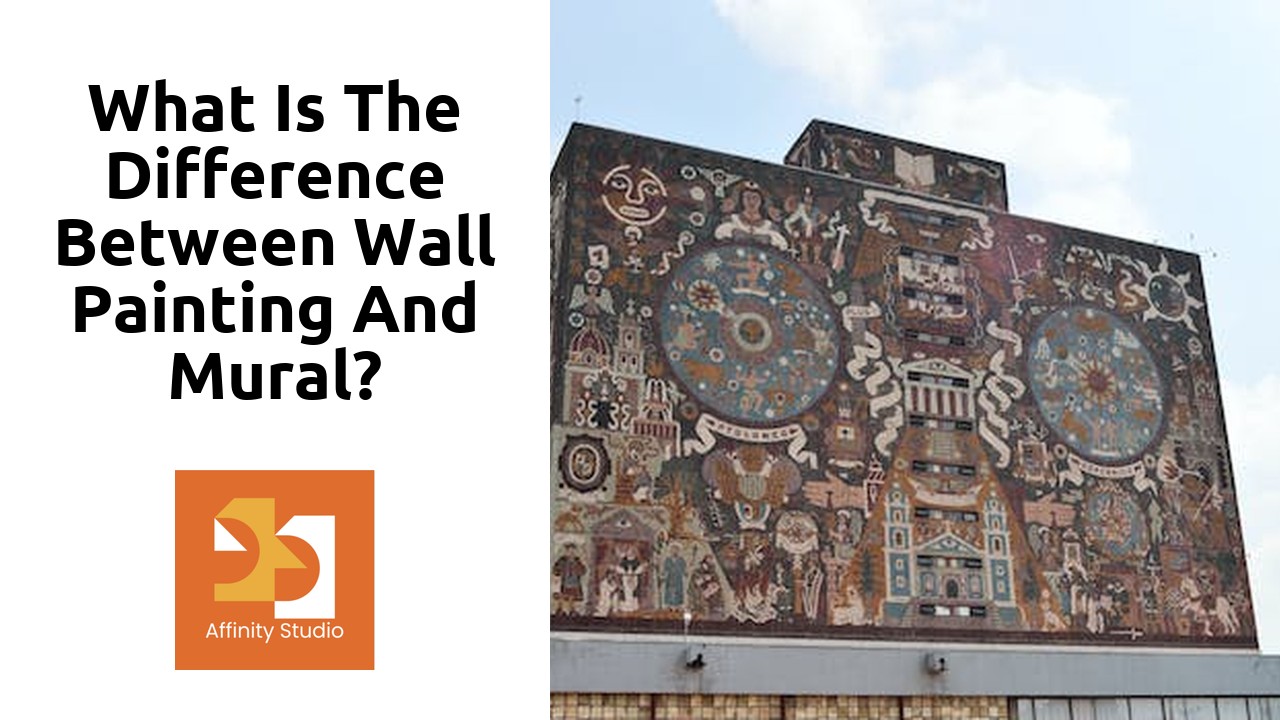Table Of Contents
Unveiling the Distinctions: Exploring Wall Art and Murals
Wall art and murals are two art forms that have been used for centuries to transform plain walls into vibrant and captivating masterpieces. While they both involve creating artistic designs on walls, there are notable distinctions between these two forms of expression. A wall painting typically refers to a smaller-scale artwork that is created on a wall, often indoors. It can be a single painting or a series of smaller paintings arranged on a wall. Wall paintings can range from abstract designs to realistic depictions of various subjects, such as landscapes, portraits, or still life. The purpose of wall paintings is to enhance the aesthetics of a space, adding color, texture, and visual interest to the walls.
On the other hand, murals are larger-scale artworks that cover a significant portion or even the entire surface of a wall. Unlike wall paintings, murals are often created outdoors on public buildings, walls along streets, or other open spaces. They are intended to engage and communicate with the community, often conveying a specific message or reflecting the culture and history of a place. Murals can be created using various techniques, such as painting directly onto the wall or using adhesive vinyl or ceramic tiles. The scale and impact of murals are essential elements of their artistic value, as they aim to transform the perception of a space and create a sense of identity and pride within a community.
Despite their differences, both wall paintings and murals have the power to captivate viewers, evoke emotions, and tell stories through visual art. Whether it is a small-scale painting in an interior space or a large-scale mural on a public building, these art forms contribute to the vibrancy and cultural richness of our surroundings. As we continue to appreciate and explore the distinctions between wall art and murals, we gain a deeper understanding of the diverse ways in which artists express themselves and transform our shared spaces into works of art.
Hop over here to discover more.
From Blank Canvas to Masterpiece: Unraveling Wall Paintings and Murals
Before we delve into the distinctions between wall paintings and murals, it’s important to understand the creative journey that transforms a blank canvas into a captivating masterpiece. Both wall paintings and murals start with a clean slate, a blank wall waiting to be transformed into an artistic marvel. Artists begin by carefully planning their design, envisioning how the space will come to life with their brushstrokes. With precise measurements and calculations, they outline their composition, ensuring every element is in perfect harmony.
Once the design is finalized, the artist moves on to the actual painting process. Layers upon layers of paint are meticulously applied, each brushstroke bringing the artwork to life. The artist’s skill and technique are put to the test as they blend colors, create texture, and bring depth to the piece. Hours of dedication and creativity are poured into the canvas, as every stroke contributes to the overall vision. The transformation from a blank wall to a mesmerizing artwork is a testament to the artist’s talent and passion.
The Artistry of Walls: Distinguishing Between Wall Paintings and Murals
When it comes to the artistry of walls, two prominent forms that often come to mind are wall paintings and murals. While both involve the creation of visual images on walls, there are distinct differences between these two forms. Wall paintings, also known as frescoes, have a long history dating back to ancient civilizations. They typically involve the use of paint directly applied to the wall surface, often depicting scenes, patterns, or decorative elements. These paintings can vary in size and complexity, ranging from small-scale designs to large-scale compositions that cover entire walls or even entire buildings.
On the other hand, murals are a more recent development in the world of wall art. Unlike wall paintings, murals often involve the use of additional materials such as tiles, mosaics, or even three-dimensional elements to create a multidimensional effect. Murals are usually larger in scale and are commonly found in public spaces such as parks, streets, and buildings, serving as a form of public expression or storytelling. They can convey political or social messages, showcase cultural heritage, or simply enhance the aesthetics of a space.
A Closer Look: Comparing Wall Art and Murals
When comparing wall art and murals, it becomes apparent that there are significant distinctions between the two. Wall art encompasses a wide range of artistic expressions that are created directly on the walls of a given space. It often includes paintings, drawings, graffiti, or any form of artistic representation that adorns the walls. Wall art can vary in style, technique, and message, as it allows artists to express their creativity and leave their mark on a particular environment.
On the other hand, murals are a specific type of wall art that often tell a story or convey a particular theme. Murals are usually larger in scale and more intricate in design than other forms of wall art. They involve a more elaborate process, with artists carefully planning and executing their vision, sometimes even involving community collaboration. Murals have the power to transform a dull and ordinary space into a vibrant and visually appealing masterpiece that captivates and engages viewers. Their larger-than-life nature makes them a prominent feature in public spaces, contributing to the aesthetic and cultural identity of a community.
While wall art and murals share the commonality of being artistic expressions on walls, their distinct characteristics set them apart. However, both have the potential to enhance the environment they inhabit, bringing beauty, creativity, and a sense of identity to the spaces they occupy.
Transforming Spaces: Understanding the Variances of Wall Paintings and Murals
Wall paintings and murals have long been used as a means of transforming spaces and creating unique visual experiences. While both art forms involve painting on walls, there are distinct differences that set them apart. Understanding these variances is essential for appreciating the artistic value and impact of each.
Wall paintings typically refer to paintings that are directly applied to the surface of a wall. They can be small or large in scale and can depict a wide range of subjects, from landscapes to portraits to abstract designs. The process of creating a wall painting often involves meticulously planning and executing the composition, as well as paying attention to the size and proportions of the artwork in relation to the wall. The end result is a piece of art that becomes an integral part of the wall, adding color, texture, and visual interest to the space.
On the other hand, murals are larger in scale and are often more intricate and detailed than wall paintings. They are typically created to tell a story, convey a message, or make a powerful visual impact. Murals can cover entire walls or even entire buildings, and they can incorporate various artistic techniques and styles, such as realistic or abstract representations, mosaic designs, or trompe-l’oeil effects. The creation of a mural often requires careful planning, extensive sketching, and collaboration with other artists or community members. The end result is a captivating and immersive artwork that transforms the space it occupies and engages viewers on a deeper level.
Brushstrokes and Imagination: Delving into Wall Art and Murals
Both wall art and murals involve the creative use of brushstrokes and imagination to transform a blank canvas into a captivating masterpiece. However, there are subtle distinctions that set them apart. Wall art refers to any form of artistic expression that is applied directly to a wall surface. It can include paintings, drawings, stencils, or even graffiti. The beauty of wall art lies in its ability to enhance the aesthetics of a space and create a visual impact. Whether it’s a small piece in a residential home or a large-scale mural in a public area, wall art has the power to capture attention and convey a message.
On the other hand, murals are a specific type of wall art that usually covers a larger area and tells a story or communicates a theme. Murals are often more detailed and intricate, requiring a high level of skill and artistic ability. They can be found in public spaces, such as city walls or buildings, as well as in private settings, such as homes or businesses. Murals have the ability to transform a plain wall into a vibrant and immersive experience for viewers. They can evoke emotions, inspire, or provide a sense of unity within a community. Whether it’s a realistic depiction or an abstract interpretation, murals have the power to create a lasting impression on those who encounter them.
FAQS
What exactly is a wall painting?
A wall painting refers to the act of painting directly on a wall surface, often using various types of paint or pigments.
What is a mural?
A mural is a large-scale artwork or painting that is created on a wall or any other permanent surface. It usually depicts a specific theme or message and is often more elaborate than a regular wall painting.
What is the main distinction between a wall painting and a mural?
The main distinction lies in the scale and complexity of the artwork. While a wall painting is usually smaller and simpler, a mural is larger in size and more intricate in design.
Can wall paintings and murals be created using the same techniques?
Yes, both wall paintings and murals can be created using similar techniques such as brushstrokes, paint application, and color mixing. However, murals often require more advanced techniques due to their larger size.
Are wall paintings and murals permanent?
Both wall paintings and murals can be permanent if created using durable paints or materials. However, they can also be temporary, especially if created for specific events or exhibitions.
Can wall paintings and murals be created indoors and outdoors?
Yes, both wall paintings and murals can be created both indoors and outdoors. However, outdoor murals are more common due to the availability of larger wall spaces and the public nature of their display.
Do wall paintings and murals serve different purposes?
While both wall paintings and murals are forms of artistic expression, their purposes can vary. Wall paintings are often used for decorative purposes or to create a specific ambiance, while murals can convey social, cultural, or political messages.
Can anyone create a wall painting or mural?
Yes, anyone with artistic skills and creativity can create a wall painting or mural. However, larger and more complex murals often require specialized training or experience.
How long does it take to create a wall painting or mural?
The time required to create a wall painting or mural depends on its size, complexity, and the artist’s skill level. It can range from a few hours to several weeks or even months for highly detailed and intricate murals.
Are there any famous examples of wall paintings and murals?
Yes, there are numerous famous examples of wall paintings and murals around the world, such as the frescoes in the Sistine Chapel and the murals by Diego Rivera in Mexico City.




